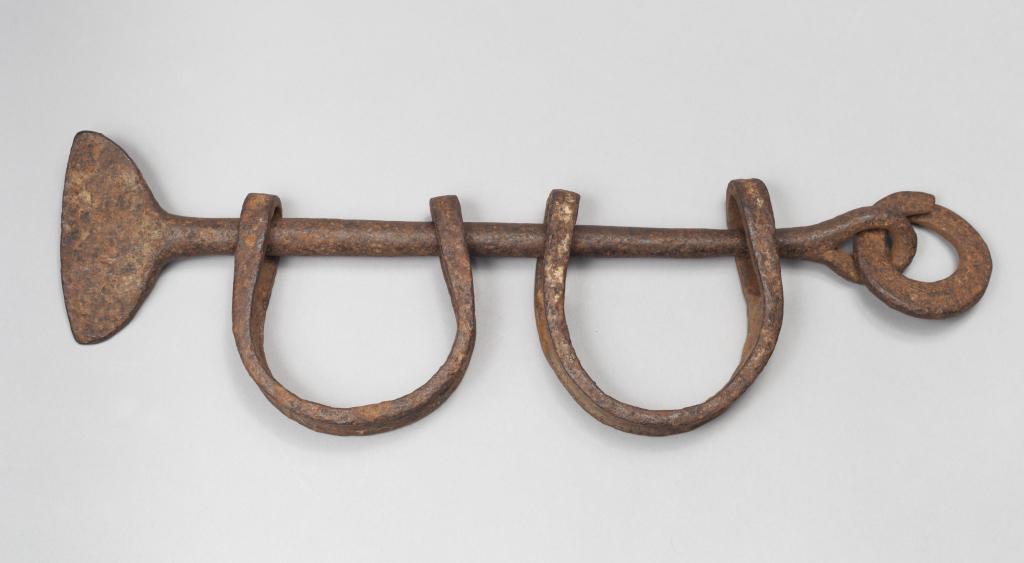Community-led project exposes links between slavery and art
Wrought iron ankle shackles from the International Slavery Museum will be permanently relocated to the Walker Art Gallery in a bid to confront and expose the colonial links between slavery and art.

Wrought iron ankle shackles from the International Slavery Museum will be permanently relocated to the Walker Art Gallery in a bid to confront and expose the colonial links between slavery and art. The ankle shackles are the type used during the so-called ‘Middle Passage’ to restrain and imprison African people below decks in the ship’s hold.
A steering group of marginalised young people from Liverpool have come together to address the erasure of colonial history in the Walker’s sculpture display. Through a series of workshops, talks, and independent research, the group learnt about the colonial legacies of the Liverpool Sandbach family. The Walker’s collection has a number of portraits depicting the family made by and attributed to Liverpool’s leading sculptor John Gibson (1790-1866).
The group questioned where the money came from that made these significant artworks. They also explored how the family’s wealth influenced the cultural, political and social development of the city today. The decision to display the ankle shackles beside the Sandbach portraits was made to show that slavery does not only exist in history, and inside the walls of the International Slavery Museum, but that its legacies are still present in our streets, in our buildings and in our culture today.
The Colonial Legacies of the Liverpool Sandbach Family project is funded by the Understanding British Portrait network. Through in-depth research, the project investigated the family’s links to slavery. It is the first project of its kind at the Walker Art Gallery, and part of National Museums Liverpool’s ongoing work to address the history and legacy of slavery, empire and colonialism across its venues.
Alex Patterson, Assistant Curator of Fine Art at National Museums Liverpool, said: “This project tells the uncomfortable truth about these objects – who commissioned them, and where the money came from to pay for them. In the past, these histories have been overlooked, ignored, or purposely omitted from public view – this has meant we have only been telling one side of the story.
“I have learnt so much from the group and I’m extremely grateful to have been part of their conversations, which were sometimes very personal and challenging for them. Individually and together, I admire their drive, their ability to think outside the box, and to challenge the institutions and the hierarchies that exist inside them.
“To embed change and equality, I believe working closely with underrepresented people should be at the heart of everything we do. By platforming multiple perspectives in our museum spaces, we can more meaningfully engage with audiences and communities.”
The family were part of the Sandbach, Tinne & Co. dynasty. They were shipowners, merchants, bankers, politicians and plantation owners. They exported sugar, coffee, cotton, timber, molasses and rum from the Caribbean. The company were prominent in Demerara, Berbice, and Essequibo in British Guiana, now known as Guyana. The Sandbachs became extremely wealthy through the enslavement, trafficking and forced labour of many tens of thousands of people. The family were also awarded large claims in compensation after the Abolition of Slavery (1833).
Working with Liverpool’s marginalised communities gives a platform and a voice to underrepresented young people in the city. The group also worked with local artists and historians such as Malik Al Nasir, whose PhD studies at the University of Cambridge explore his own ancestral links to both the Sandbach, Tinne & Co. dynasty, and the Africans enslaved by them, and Laurence Westgaph who runs the Liverpool and Slavery History Group and is currently National Museums Liverpool’s resident historian.
The steering group independently recorded and produced their own audio recording as part of the project, which is available on the Walker’s website. The recording allows listeners to hear first-hand their discussions, unique perspectives and, at times, their difficult experiences of racial trauma.
Members of the steering group include: Amna Akram, Rabia Begum, Safiya Burnett-Charles, Iman Hasan, Rebecca Ihiekwe, Gavin Odhiambo Okello-Davies, Hatou Tangikora and facilitator Tavia Panton.
Steering group member Hatou Tangikora said: “It’s an opportunity to learn and educate yourself about Black history, and the importance it had on the past, and the impact it still has on the present and future.”
Tavia Panton, steering group facilitator, commented: “It was great to bring out perspectives of young people and to explore the themes from the NML (National Museums Liverpool) perspective and resources. This work is important because it makes a difference to how we understand ourselves and others around us.”
Gavin Odhiambo Okello-Davies, steering group member, added: “It’s a revolutionary project that deserves the world’s attention. We’ve paved a path for so many future generations of PGM (People of Global Majority). We’ve got so much to explore as a national and international community.”
For further information on the project, visit liverpoolmuseums.org.uk/Sandbach-Research-Project
ENDS
ADDITIONAL QUOTES AND LINKS
Malik Al Nasir said: “It was inspiring to see young people engage with such passion in the Sandbach family research. They are pioneers in what is fast becoming a major new take on the history of Liverpool and enslavement."
National Museums Liverpool is one of the partners working with Liverpool City Council to place plaques across the city explaining the links to slavery that lie behind many street names. The first plaque was installed on William Brown Street, where the Walker is located, in April 2022. To find out more, visit www.liverpoolslaveryhistories.co.uk
For further information on National Museums Liverpool’s commitments in response to the Black Lives Matter movement, visit liverpoolmuseums.org.uk/blacklivesmatter
To learn more about Malik Al Nasir’s research, visit https://www.bbc.co.uk/news/extra/3k9u8lh178/Searching_for_my_slave_roots
FURTHER INFORMATION
Felicity Robinson
PR and Communications Officer
felicity.robinson@liverpoolmuseums.org.uk
